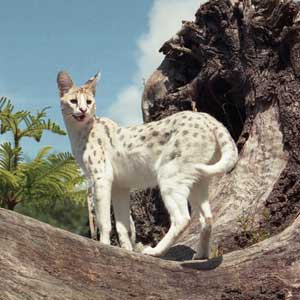Serval






Serval (Leptailurus serval) is a wild cat native to Africa. It is known for its distinctive long legs, large ears, and spotted coat, making it one of the most easily recognizable felids on the continent. Servals inhabit various environments, including savannahs, grasslands, and moist areas close to water bodies, but they avoid dense equatorial jungles. This article provides an overview of the serval, including its physical characteristics, behavior, diet, and conservation status.
Physical Characteristics[edit]
The serval is notable for its slender body, long legs, and a short tail. Its coat is yellowish-tan to gold with black spots and stripes, which serve as camouflage in the tall grasses of its environment. The serval's large ears are used to detect the faintest sounds, aiding in the location of prey. Adults can weigh between 9 to 18 kilograms (20 to 40 lbs), with a body length of up to 60 cm (24 in) at the shoulder.
Behavior[edit]
Servals are solitary animals, with territories that range widely depending on the availability of prey. They are primarily nocturnal but can also be active during the day, especially in cooler weather. Servals communicate through vocalizations, scent markings, and visual signals. They are known for their ability to leap vertically and catch prey such as birds, mid-flight.
Diet[edit]
The diet of the serval consists mainly of rodents, small birds, frogs, insects, and fish. They are skilled hunters, using their acute sense of hearing to locate prey before pouncing. Servals have been observed leaping high into the air to catch birds or swiftly digging into burrows to catch rodents.
Reproduction[edit]
Servals reach sexual maturity at about 2 years of age. After a gestation period of approximately 73 days, the female gives birth to a litter of one to four kittens. The kittens are born blind and are dependent on their mother for the first few months of their lives. They are weaned at about 5 months old but may stay with their mother for up to a year.
Conservation Status[edit]
The International Union for Conservation of Nature (IUCN) currently lists the serval as Least Concern. However, they face threats from habitat loss due to agricultural expansion and human settlement. In some areas, servals are hunted for their pelts. Conservation efforts are focused on habitat protection and legal protection from hunting.
In Culture[edit]
Servals have been kept as pets and in captivity for centuries, sometimes even being worshipped by ancient civilizations. Today, they are sometimes kept as exotic pets, although their wild nature and specific care needs make them unsuitable for most households.
Ad. Transform your life with W8MD's Budget GLP-1 injections from $75


W8MD offers a medical weight loss program to lose weight in Philadelphia. Our physician-supervised medical weight loss provides:
- Weight loss injections in NYC (generic and brand names):
- Zepbound / Mounjaro, Wegovy / Ozempic, Saxenda
- Most insurances accepted or discounted self-pay rates. We will obtain insurance prior authorizations if needed.
- Generic GLP1 weight loss injections from $75 for the starting dose.
- Also offer prescription weight loss medications including Phentermine, Qsymia, Diethylpropion, Contrave etc.
NYC weight loss doctor appointmentsNYC weight loss doctor appointments
Start your NYC weight loss journey today at our NYC medical weight loss and Philadelphia medical weight loss clinics.
- Call 718-946-5500 to lose weight in NYC or for medical weight loss in Philadelphia 215-676-2334.
- Tags:NYC medical weight loss, Philadelphia lose weight Zepbound NYC, Budget GLP1 weight loss injections, Wegovy Philadelphia, Wegovy NYC, Philadelphia medical weight loss, Brookly weight loss and Wegovy NYC
|
WikiMD's Wellness Encyclopedia |
| Let Food Be Thy Medicine Medicine Thy Food - Hippocrates |
Medical Disclaimer: WikiMD is not a substitute for professional medical advice. The information on WikiMD is provided as an information resource only, may be incorrect, outdated or misleading, and is not to be used or relied on for any diagnostic or treatment purposes. Please consult your health care provider before making any healthcare decisions or for guidance about a specific medical condition. WikiMD expressly disclaims responsibility, and shall have no liability, for any damages, loss, injury, or liability whatsoever suffered as a result of your reliance on the information contained in this site. By visiting this site you agree to the foregoing terms and conditions, which may from time to time be changed or supplemented by WikiMD. If you do not agree to the foregoing terms and conditions, you should not enter or use this site. See full disclaimer.
Credits:Most images are courtesy of Wikimedia commons, and templates, categories Wikipedia, licensed under CC BY SA or similar.
Translate this page: - East Asian
中文,
日本,
한국어,
South Asian
हिन्दी,
தமிழ்,
తెలుగు,
Urdu,
ಕನ್ನಡ,
Southeast Asian
Indonesian,
Vietnamese,
Thai,
မြန်မာဘာသာ,
বাংলা
European
español,
Deutsch,
français,
Greek,
português do Brasil,
polski,
română,
русский,
Nederlands,
norsk,
svenska,
suomi,
Italian
Middle Eastern & African
عربى,
Turkish,
Persian,
Hebrew,
Afrikaans,
isiZulu,
Kiswahili,
Other
Bulgarian,
Hungarian,
Czech,
Swedish,
മലയാളം,
मराठी,
ਪੰਜਾਬੀ,
ગુજરાતી,
Portuguese,
Ukrainian
